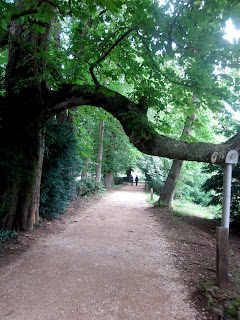 |
| Magdalen College |
Last Thursday (the 19th), we spent a day devoted
to the C.S. Lewis sites in Oxford.
We first went to Magdalen College where he taught. We saw the beautiful chapel where a
plaque denoting his “chapel seat” was and heard anecdotes from the wonderful
tour guide. We learned Lewis was
popular among students for giving them beer during tutorial sessions. Many students were often nervous about
first going to these sessions, but they soon relaxed as Lewis would be smoking and
offer them a drink. He liked to
have “Beer and Beowulf” nights with students. My other favorite anecdote was that another professor was
doing animal research, which Lewis strongly disagreed with. To show his disapproval, he would meow
at the other professor whenever he passed him. In addition, we learned Lewis didn’t always get along with
his other colleagues. He struggled
with their disregard for his Christian faith. Since Oxford never made him a chair, Lewis eventually went
to Cambridge’s Magdalen College to become a chair of English. He said he felt more accepted there as
a Christian. He still kept his
house in Oxford though and would come back on the weekends.
 |
| Addison's Walk |
After
the tour we went on the famous Addison’s Walk where Lewis and Tolkien would
have long talks about God. On one
of these walks Lewis’ perspective changed, and he began to believe that there
was a God, but he did not become a Christian until much later.
Later
in the afternoon, we went to the Kilns, which is where Lewis lived. We first explored the back wooded part
that surrounded a pond Lewis liked to swim in (Lewis loved to swim, and he was
even caught as a student skinny-dipping in University Park. All the other male students he was with
covered themselves, but Lewis covered his face. Wise move). The woods were beautiful and contained an old
brick bench that Lewis and Tolkien used to sit on to talk whenever Tolkien
would visit.
 |
| The Kilns |
The
house itself has been refurbished to look as it did during Lewis’ time. That is a good thing as Lewis and his
brother Warnie who also lived there, were terrible housekeepers. They both smoke and drank quite a bit,
and they were known to grind the ash from their cigarettes into the carpet to
“keep the moths away.” They smoked
so much they turned the walls of the house yellow.
This
is the house where children stayed during the War to be safe from the bombs of
London. They inspired the Pevensie
children of the Narnia series.
In
addition, we got to hear stories about Lewis’ marriage to Joy Davidson. Lewis married later in life, and he
first married Joy only so she wouldn’t be deported back to America. He wouldn’t even let her live with him
(he seemed to be set in his ways) until after she was diagnosed with
cancer. This diagnosis woke Lewis
up to the fact that he did love her.
Joy was a very fiery American woman from the Bronx. My favorite story about her is when
their were trespassers on their property she bought a rifle to scare them
off. One day, she and Lewis were
out walking and they caught some one trespassing and shooting arrows. He turned the arrows on them when Lewis
asked him to leave. Lewis
gallantly stepped in front of Joy to protect her, and she said, “Dammit Jack!
You’re in my line of fire!” There
was a picture in the house of her with this rifle and she looked
terrifying. The tour guide said
she was one of the few women who could have stood up to Lewis and kept him in
line.
After
the tour of the Kilns we visited Lewis’ grave and church. Lewis was known for sneaking into
church late and leaving early, as socializing was not his forte. The church honors him with a plaque on
his pew and a Narnia themed stained glass window.
 |
| Lewis' grave |
 |
| The Narnia Window |
All
in all, this was one of my favorite trips. I’ve read Lewis all my life, and I always had a view of him
as this paragon of Evangelical Christianity who was almost perfect. This trip showed me that Lewis was a
very human man who was very kind and charitable, but he also loved to drink,
smoke, and was kind of crotchety.
It was refreshing to seem him as a fellow human who was saved by grace
as we all are, which I realized is what his books are at their core all
about.














































